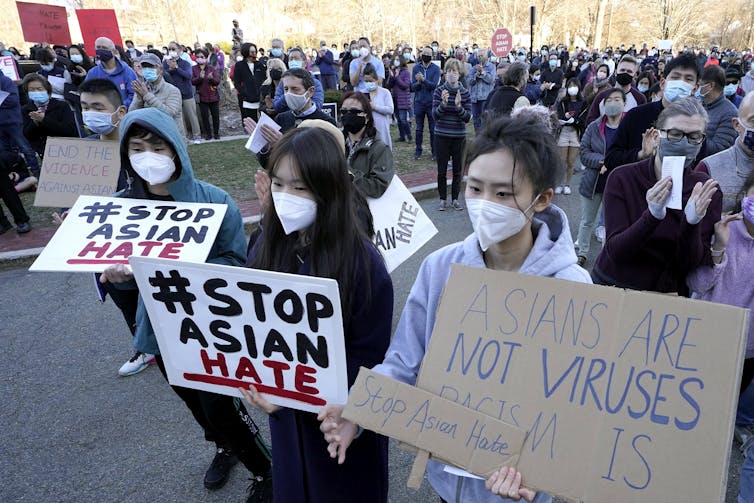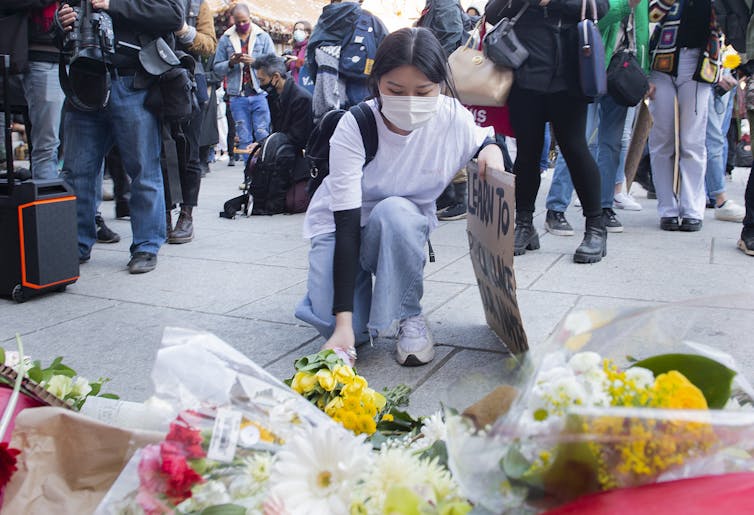By Jiyoung Lee-An and Xiaobei Chen
Six women of Asian descent were among eight people tragically killed in a targeted shooting on March 16 in Atlanta. The initial denial by the Atlanta police that this was a hate crime, along with some news reports highlighting the offender’s version of the incident, evoked a swift reaction by communities all over North America. Many spoke of the invisibility of anti-Asian racism.
One of the reasons for the invisibility of anti-Asian racism is inextricably connected to the model minority myth. The model minority myth focuses on prevailing stereotypes of Asians as hard-working, independent, intelligent and economically prosperous.
But the stereotypes — while seemingly positive — hide many issues, including anti-Asian racism, poverty, labour abuse and psychological needs. It disappears the realities of working-class Asian women’s lives.
The myth has also sometimes disrupted inter-racial solidarity and has been used against Indigenous, Black and other racialized groups.
The reality of working-class Asians
The Asian model minority myth was popularized by sociologist William Pettersen through a 1966 New York Times article. For the past several decades, the Asian model minority myth has been prevalent in the general public as a counter-argument for anti-Asian racism.
The myth is that Asians are rule-abiding and thus do not have needs that warrant societal and government policy concerns.

(AP Photo/Steven Senne)
Some even talk about reverse discrimination and highlight a few successful stories of Asian Americans and Asian Canadians. Leaders have used examples of Asian Canadian and Asian American success to deny deeply rooted systemic racism and instead point to that success as evidence of a “colour-blind” society.
However, this celebratory tone systemically excludes the reality of working-class Asian Canadians and Asian Americans. It also excludes a specific form of anti-Asian racism against Asian women that is intertwined with gender and sexuality.
Fear of failure
The Asian model minority myth produces Asian subjects who are encouraged to be the model, in other words, the non-trouble-making minority. The narrative creates this idea of the essentialist “other” — those who are part of the “model” group. It also discourages that group’s potential collective actions to overcome challenges.
Numerous studies have shown that the model minority myth itself causes a fear of failing to conform to the positive stereotype among Asians.
The sentiment that we ought to “take care of the problem ourselves, without troubling others” (as someone said in a research interview) hides socio-economic, political, educational and psychological needs of Asian Canadians from public view.
High poverty rates
Contrary to common notions about Asian Canadians’ economic success, an analysis of Canada’s 2016 census data shows that “among Korean, Arab and West Asian Canadians, the poverty rate ranged from 27 per cent to 32 per cent.” Among Chinese and also Black Canadians, the poverty rate reached 20 per cent. Filipinos were the only visible minority group that had a lower poverty rate (7.2 per cent) than the white population (12.2 per cent).
While Asian Canadians are highly represented in skilled occupations, particularly among those born in Canada, the high poverty rates of Asian Canadians suggest that they are also over-represented in low-paying occupations, particularly among immigrants.
However, these statistics do not clearly show the feminized poverty, violence and exploitation that many Asian women face due to their precarious immigration status, gender stereotyping and fetishization of Asian women’s bodies.
In fact, anti-Asian racism is intertwined with the sexualization of Asian women, a fetishization of Asian women’s bodies and the stigmatization of sex work.
Colonial ideas of ‘orientalism’
The sexualization of Asian women stems from a history of European colonization of the Asia Pacific as well as colonial ideas of orientalism that constructed Asian women as “exotic” sexual objects. In North America, settler colonialism constructed Asian immigrants as threats to the biological reproduction of the white nation.

(Brown/Library and Archives Canada, C-006686B)
One example of this is the Chinese Head Tax and the Chinese Exclusion Act in Canada during the late 19th and early 20th centuries. Surrounding the immigration ban, Chinese women’s sexuality was constructed as immoral compared to white women. Their exclusion to legitimate immigration was justified by constructing Chinese women as potential “sex workers.”
Femininized workforce
Asian women migrants are mainly employed in a feminized workforce, including domestic and care work, service industry and the sex industry. These feminized low-paying workforces have traditionally been considered white women’s work but are now mostly taken up by racialized women. In this work, Asian women workers are stereotyped as “ideal” docile labour.

THE CANADIAN PRESS/Graham Hughes
Asian women workers who have precarious migration status are particularly vulnerable to labour exploitation, abuses and police violence from potential deportation threats. However, these women’s stories remain silenced in the celebrated myth of Asian success.
The model minority myth repeats symbolic and racist traps. To move beyond this, alternative narratives are needed to build solidarity both within Asian groups and with other racialized people.
This article is republished from The Conversation under a Creative Commons license. Carleton University is a member of this unique digital journalism platform that launched in June 2017 to boost visibility of Canada’s academic faculty and researchers. Interested in writing a piece? Please contact Steven Reid or sign up to become an author.
All photos provided by The Conversation from various sources.
![]()
Monday, March 29, 2021 in The Conversation
Share: Twitter, Facebook



